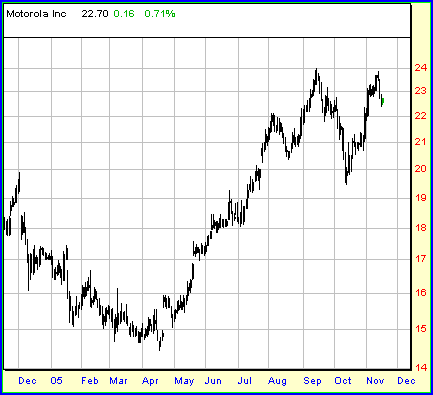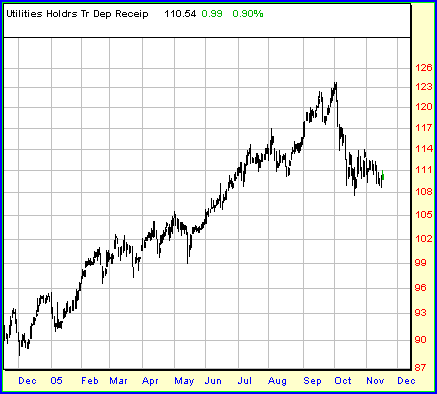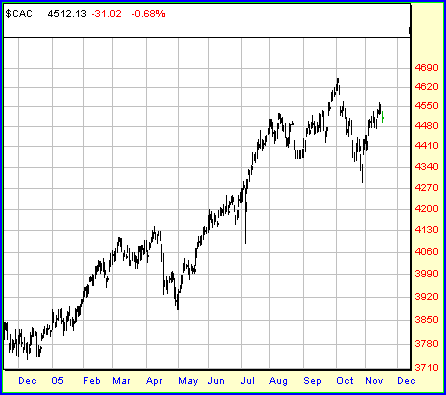
HOT TOPICS LIST
- Strategies
- Stocks
- Buy
- Investing
- Brokers
- Psychology
- Interviews
- Accumulate
- Sell
- Hold
- Spotlight
- Websites
- Candlestick Corner
- Gold & Metals
- Options Trading
LIST OF TOPICS
VIEWS FROM THE FIELD
Magnets And Market Direction
11/23/05 10:29:14 AM PSTby David Penn
A conversation and market update with Jordan Kimmel of Magnet Investing.
| What do you do when you cross market direction analysis with a laser-like focus on individual stock selection? According to Magnet Investing's Jordan Kimmel, the answer is simple: a better than halfway decent shot at outperformance. Speaking with Kimmel recently by telephone, I was curious how a market as schizophrenic as the current one has affected a stock selection process that seems on the surface to be wholly agnostic to the complexities of divining market direction. As Working Money readers learned in our last conversation with Kimmel in August of this year, Kimmel's Magnet Investing approach incorporates both fundamental and technical analysis in a CANSLIM-like method of picking the wheat of winning stocks from what is often the chaff of the broader marketplace. Such "chaff" has certainly been the case of late, as a bear market in the first few months of the year begot a bull market over the next several months, only to leave investors more or less where they began the year. "You can't think your companies are invulnerable," warns Kimmel in talking about how even the Magnet Investing approach needs to be cognizant of the greater tides of the market. "If and when [a] sector rolls over, so will most of the companies in that group." Fresh in Kimmel's mind clearly are the oil stocks, which had been highly rated "Magnet Stocks" months before they caught on with the investing public. It was this attention to invidual stocks ("more than anything we continue to be focused on individual stock selection") that caused oil stock after oil stock to appear on Magnet's screens for companies likely to outperform going forward. "[We] didn't find these companies by being intuitive or smart," Kimmel admits. "We followed the model and the model pulled us into these names." The fact of the matter is that sooner or later, as far as he is concerned, high levels of revenue growth — with margin creation — will eventually pull in other investors. "Their relative strength gets better and better," he says. And it is the crush of other investors joining the party that helps raise the stock price for those who already own the shares, such as Kimmel and investors in his funds.
MAGNETS ATTRACT One excellent example of this process, as far as Kimmel is concerned, was the technology stocks. So many people believed that "tech was dead," he notes. But that had to do with a key flaw in most investors' understanding of what "tech" was in 2005. Hint: not what it was in 1999. "People kept looking at the old tech leaders — Dell, Intel, Sun Microsystems," he says. "None of those stocks ranked highly for us." On the other hand, new technology names like Sandisk, Apple Computer, and Motorola did. Adds Kimmel, "Because of the way the [NASDAQ] index was constructed, it appeared as if NASDAQ [stocks] were doing nothing." He chalks this up to the "limitations of the four horsemen" — namely, the three old tech leaders plus a company like Cisco — and encourages investors and speculators to look beyond the index and more closely at the actual components.
Figure 1: Motorola Daily. Motorola is among the signature companies participating in the technology rally in the second half of 2005.
"There was a lot of thinking that the good tech [stocks] had already run their course," he recalls. "But solid technology stocks kept showing up on the Magnet screen. We were literally forced to keep invested in these stocks." So what has to happen for Kimmel and his investors to get forced out of a stock? "As long as something remains highly ranked, we stay with it," he answers, "until it begins to roll over technically or becomes so overvalued relative to Magnet criteria that it deselects itself." He provides the example of a company growing at 40% trading at 20 times earnings versus a company growing at 40% trading at 60 times earnings as an example of the sort of relative overvaluation he is wary of. At the same time, there are many stocks that simply can't get out of their own way. GE is an example of the kind of company that "may be too big," he says. Its prospects may improve, and the fundamentals are strong, "but the stock is completely stuck." Other examples of this phenomenon include stocks as different from each other in all other respects as Home Depot and Amgen. "After a multiyear run," he explains, "the fundamentals stay good, but prices have to digest. A huge run, then sideways for years, digesting that move." Says Kimmel, this only emphasizes the importance of "distinguishing good companies from good — or timely — investments."
SECTOR SAVVY How do average investors and speculators figure out where in the rotation the market is? As far as he is concerned, the old school business "boom 'n bust" theory is flawed when put in the context of a global market. The best bet? "Stick to the model," he insists. "How many stocks in what groups are doing well. Don't be worried about what should be happening, focus on what is." One of the relative drawbacks with the Magnet stock selection process is that there will always be something that falls through the cracks. Usually, these sectors that fly below the Magnet radar do so because the components of such sectors tend to be less vigorous growers compared to many other sectors such as technology, retail, finance, industrial production and basic materials, and so on. Gold mining companies, for example, have tended not to rank as highly in the Magnet process as do stocks from other sectors.
Figure 2: Utilities HOLDRS Daily. One of the advantages of technical analysis is that it can clue in investors and speculators to sectors like utilities that occasionally go overlooked by "growth-oriented" stock selection strategies.
Another group that will tend to be overlooked in the Magnet process is the utilities group. In fact, along with his analysis of the gold mining companies, he points out that this is a good example of why to factor in technical analysis into the model. Says Kimmel about the problem of exclusively focusing on the fundamentals — particularly revenue growth and margin acceleration — we "looked for components [of the utilities group], but just [didn't find] much growth." He notes, "Energy trading helped many utilities for a while, but then a lot got crushed." On the other hand, there are hot sectors — or at least hot until recently — that the Magnet stock selection process did pick up. Housing stocks, Kimmel says, were a powerful group that he picked up on years ago, and continue to rank highly even though, he adds, "A lot of smart people think we're in a bubble and bound to crash." Even though many of these stocks pulled back to support, many have not truly broken down as of yet. Adds Kimmel, "There is a side of us that always tries to outguess the market... it would have paid to follow the model instead."
MARKETS MOVING FORWARD According to Kimmel, we are living through a period in which we have the highest levels of cash sitting on the sidelines in history. And by his calculation, worldwide liquidity coupled with pessimism indicates a market that is ready to head much higher. "Every ingredient is there but confidence," he says. And where does that confidence come from? "Two things bother investors," he adds, "losing money and watching people making money." It might not be Rocky II confidence, but it might be the kind of "me-tooism" that will bring more and more investors and speculators back into the markets. What other sort of catalysts might appear to move the markets higher? Kimmel points to the Federal Reserve. "The current Fed [chairman] is leaving an opportunity for the new Fed [chairman] to begin lowering rates by the spring of next year," he says. He anticipates that fear of a cooling economy — that might be getting colder faster than some expected — will help stoke rate reductions.
Figure 3: France's CAC Daily. Vive la difference? The French stock market is among those that have outperformed the US market by a significant margin.
Add to this good news on the tradefront the fact that the US market is actually lagging behind many world markets, and Kimmel's recipe for gains becomes all the more savory. But he warns investors and speculators not to pay too much attention to the major market indexes if you're looking for signs of this happening. "The best investment strategy is when you can identify sector rotation that is either coming or underway," he says. "Then find the 'magnets' within those sectors that are gaining strength — and start exiting those sectors that are losing their relative strength." And a model like the Magnet Investing stock selection process can be invaluable when doing such analysis. Screens full of improving sectors communicate market direction almost as well as any price chart, and it is within those sectors that the best stocks lie. The model keeps the investor or speculator on track, "forcing" him or her into and out of sectors when the sectors indicate that their time has come (or gone). Says Kimmel, "[The model also] helps you to control your emotions. A fair amount of experience is good, but often people outsmart themselves."
David Penn may be reached at DPenn@Traders.com.
SUGGESTED READING Charts courtesy Prophet Financial Systems
Current and past articles from Working Money, The Investors' Magazine, can be found at Working-Money.com.
|
Technical Writer for Technical Analysis of STOCKS & COMMODITIES magazine, Working-Money.com, and Traders.com Advantage.
| Title: | Traders.com Technical Writer |
| Company: | Technical Analysis, Inc. |
| Address: | 4757 California Avenue SW |
| Seattle, WA 98116 | |
| Phone # for sales: | 206 938 0570 |
| Fax: | 206 938 1307 |
| Website: | www.traders.com |
| E-mail address: | DPenn@traders.com |
Traders' Resource Links | |
| Charting the Stock Market: The Wyckoff Method -- Books | |
| Working-Money.com -- Online Trading Services | |
| Traders.com Advantage -- Online Trading Services | |
| Technical Analysis of Stocks & Commodities -- Publications and Newsletters | |
| Working Money, at Working-Money.com -- Publications and Newsletters | |
| Traders.com Advantage -- Publications and Newsletters | |
| Professional Traders Starter Kit -- Software | |
PRINT THIS ARTICLE

|

Request Information From Our Sponsors
- VectorVest, Inc.
- Executive Premier Workshop
- One-Day Options Course
- OptionsPro
- Retirement Income Workshop
- Sure-Fire Trading Systems (VectorVest, Inc.)
- Trading as a Business Workshop
- VectorVest 7 EOD
- VectorVest 7 RealTime/IntraDay
- VectorVest AutoTester
- VectorVest Educational Services
- VectorVest OnLine
- VectorVest Options Analyzer
- VectorVest ProGraphics v6.0
- VectorVest ProTrader 7
- VectorVest RealTime Derby Tool
- VectorVest Simulator
- VectorVest Variator
- VectorVest Watchdog
- StockCharts.com, Inc.
- Candle Patterns
- Candlestick Charting Explained
- Intermarket Technical Analysis
- John Murphy on Chart Analysis
- John Murphy's Chart Pattern Recognition
- John Murphy's Market Message
- MurphyExplainsMarketAnalysis-Intermarket Analysis
- MurphyExplainsMarketAnalysis-Visual Analysis
- StockCharts.com
- Technical Analysis of the Financial Markets
- The Visual Investor



